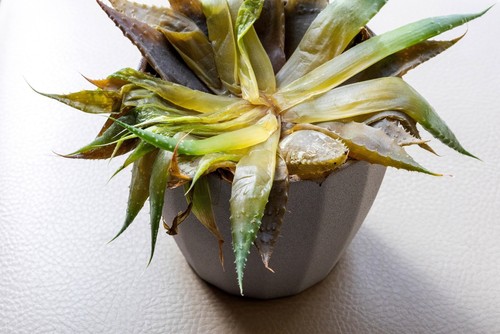Aloe plants are popular houseplants that are easy to care for, but sometimes they can start to deteriorate. If you notice that your aloe plant is dying, it’s important to act quickly to save it. Understanding the common causes of aloe plant deterioration and how to care for your plant properly can help you revive it and prevent future problems.
Signs your aloe plant is dying include yellow or brown leaves, swollen leaves, or leaves that are almost transparent. Overwatering or underwatering are common causes of aloe plant deterioration, as are lack of sunlight and cold damage.
To revive a dying aloe plant, it’s important to identify the cause of the problem and take steps to correct it, such as adjusting your watering schedule or moving the plant to a sunnier location.
Key Takeaways
- Aloe plants can deteriorate due to overwatering, underwatering, lack of sunlight, or cold damage.
- To revive a dying aloe plant, identify the cause of the problem and take steps to correct it, such as adjusting your watering schedule or moving the plant to a sunnier location.
- Preventive measures and regular care, such as proper watering and providing adequate sunlight, can help keep your aloe plant healthy and thriving.
Don’t miss these other related posts:
Recognizing Signs of a Dying Aloe Plant
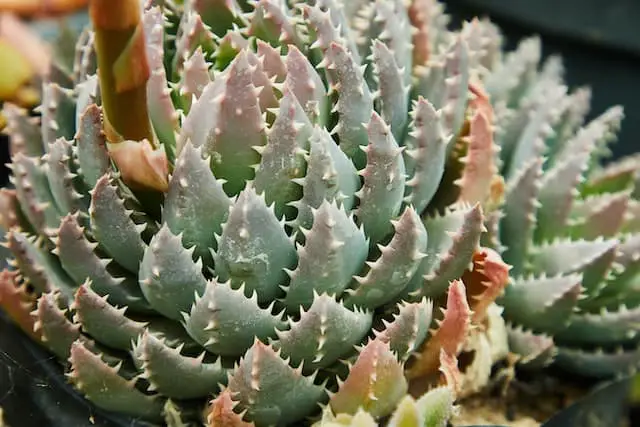
Aloe plants are hardy and resilient, but they can still suffer from a range of problems that can cause them to die. To prevent your aloe plant from dying, it’s important to recognize the signs of a dying plant. In this section, we will discuss the most common signs of a dying aloe plant.
Leaf Discoloration
One of the most noticeable signs of a dying aloe plant is leaf discoloration. If the leaves of your aloe plant are turning brown or yellow, it could be a sign that the plant is not getting enough water or that it is being overwatered.
Overwatering can cause the roots to rot, which can lead to the death of the plant. On the other hand, if the leaves are turning brown and crispy, it could be a sign that the plant is not getting enough water.
Drooping Leaves
Another sign of a dying aloe plant is drooping leaves. If the leaves of your aloe plant are drooping, it could be a sign that the plant is not getting enough water. Aloe plants are succulents and can store water in their leaves, but they still need to be watered regularly. If the leaves are drooping and soft, it could be a sign that the plant is overwatered and the roots are rotting.
Brown leaves are another sign that your aloe plant may be dying. Brown leaves can be caused by a range of problems, including overwatering, underwatering, or exposure to cold temperatures. If the leaves are brown and crispy, it’s likely that the plant is not getting enough water. If the leaves are brown and mushy, it could be a sign that the roots are rotting.
Yellow or brown leaves that are dropping off the plant can also be a sign that your aloe plant is dying. If the leaves are dropping off and the plant looks sparse, it could be a sign that the plant is not getting enough water or that it is being overwatered.
Aloe Plant is Dying – 3 Common Problems
Aloe plants are relatively easy to care for, but they can still suffer from deterioration if not given the proper care. Here are some common causes of aloe plant deterioration:
1. Watering Issues
Overwatering and underwatering are the most common watering issues that can cause aloe plants to deteriorate. Overwatering can lead to root rot, while underwatering can cause the leaves to turn brown and dry out.
It is essential to water the aloe plant only when the top 1-2 inches of soil is dry. When watering, ensure that excess water drains out of the pot to prevent root rot.
2. Temperature and Sunlight Exposure
Aloe plants require a temperature range of 60-75°F (15-24°C) and at least four hours of direct sunlight each day. Direct sunlight is essential for the plant to produce the right amount of chlorophyll, which helps the plant to grow and stay healthy. In the winter season, it’s essential to move the plant to a warmer location to prevent cold damage.
3. Pest Infestations
Pests such as aphids, scales, weevils, and whiteflies can cause severe damage to aloe plants. These pests feed on the sap of the plant, causing the leaves to wilt and turn yellow. High humidity can also attract pests, so it’s essential to keep the plant in a well-ventilated area.
In summary, proper watering, adequate sunlight exposure, and pest control are crucial for maintaining a healthy aloe plant. By taking care of your aloe plant, you can enjoy its many benefits for years to come.
Understanding the Aloe Plant’s Needs
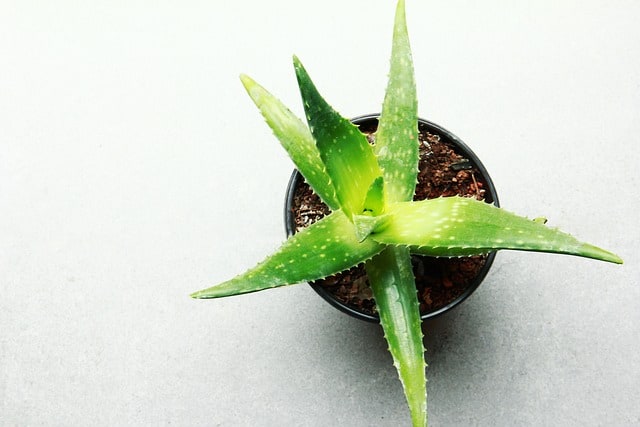
1. Pot and Drainage
When it comes to growing a healthy aloe plant, choosing the right pot and ensuring proper drainage is crucial. Aloe vera plants prefer to be in a pot with drainage holes to prevent water from sitting in the soil and causing root rot.
Terracotta pots are a great option for aloe plants, as they allow for air and water to pass through the porous material. It is important to choose a pot that is not too big for the plant, as this can lead to overwatering and root rot.
2. Soil Requirements
Aloe plants require well-draining soil to thrive. Conventional potting soil can be too dense for aloe plants, so it is recommended to mix in sand or perlite to improve drainage. A good soil mix for aloe plants should consist of 50% potting soil and 50% sand or perlite. It is important to keep the soil slightly moist, but not wet, as overwatering can lead to root rot.
3. Plant Characteristics
Aloe vera plants are a type of succulent and are known for their drought-tolerant nature. They store water in their leaves, making them able to survive in arid conditions. Aloe plants also prefer bright, indirect sunlight, and can even tolerate some direct sunlight. If an aloe plant is not receiving enough light, its leaves may become pale and thin.
It is important to note that if an aloe plant is showing signs of distress, such as yellowing or browning leaves, it may be an indication of overwatering or underwatering. A sharp knife can be used to cut away any dead or rotting leaves to promote new growth.
Reviving Your Aloe Plant
If you notice that your aloe plant is dying, don’t give up on it just yet. With the right care, you can revive your aloe plant and bring it back to life. Here are some steps you can take to help your aloe plant recover.
1. Repotting and Replanting
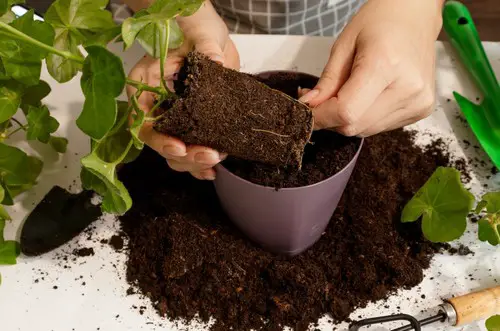
One of the first things you should do is check the container your aloe plant is in. If the container is too small or doesn’t have drainage holes, it can lead to problems like root rot. Repotting your aloe plant into a slightly larger container with drainage holes can help improve its health.
Before repotting, examine the roots of your aloe plant. If the roots are brown or mushy, they may be rotting. In this case, you’ll need to carefully remove the plant from its container and trim away any unhealthy roots. Then, replant the aloe in fresh, well-draining soil.
2. Addressing Watering Issues
Overwatering or underwatering can both cause problems for your aloe plant. If the soil is damp or the container doesn’t have drainage holes, it can lead to waterlogged roots and root rot. On the other hand, if the soil is too dry, your aloe plant may become dehydrated and start to wilt.
To address watering issues, make sure your aloe plant is in a container with drainage holes and use well-draining soil. Water your aloe deeply, but only when the top inch of soil is dry. Avoid watering too frequently or letting the soil stay damp for extended periods.
3. Dealing with Root Rot
If your aloe plant has root rot, it’s important to act quickly to save it. Remove the plant from its container and trim away any unhealthy roots. Then, replant the aloe in fresh, well-draining soil.
To prevent root rot from happening again, make sure your aloe plant is in a container with drainage holes and use well-draining soil. Avoid overwatering and let the soil dry out slightly between waterings.
Taking these steps can help revive your aloe plant and bring it back to health. With a little care and attention, you can save your aloe vera and enjoy its many benefits for years to come.
Preventive Measures and Regular Care
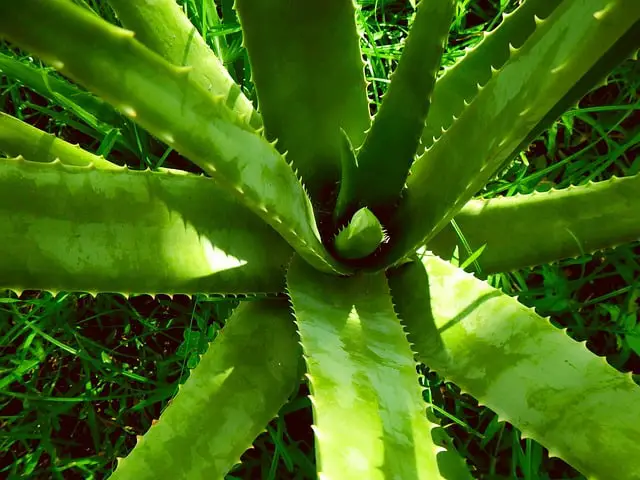
Taking preventive measures and providing regular care can help keep an aloe plant healthy and prevent it from dying. Here are some tips to help keep your aloe plant thriving.
1. Proper Feeding
Aloe plants do not require frequent feeding, but they do need some nutrients to grow. Using a fertilizer designed for cacti and succulents, like a 2-7-7 formula, can provide the necessary nutrients without overfeeding the plant. It is best to feed the plant once every three to four months during the growing season.
2. Lighting and Placement
Aloe plants require bright, indirect light to thrive. Placing the plant near a south or west-facing window can provide the necessary light. However, be careful not to expose the plant to direct sunlight, as this can scorch the leaves. If the plant is not receiving enough light, it may become leggy and weak, making it more susceptible to disease.
3. Regular Monitoring
Regular monitoring of the aloe plant can help prevent problems before they become severe. Checking the soil moisture level and adjusting watering frequency as needed can prevent overwatering, which can lead to root rot. Additionally, checking the plant for pests like mealybugs and spider mites can prevent infestations from spreading.
In addition to these preventive measures, using a well-draining cactus mix can help prevent the soil from becoming waterlogged, which can lead to root rot. Aloe plants also benefit from occasional grooming, such as removing dead or damaged leaves and repotting every two to three years.
By following these tips and providing regular care, an aloe plant can remain healthy and beautiful for years to come.
Propagating Aloe Plants
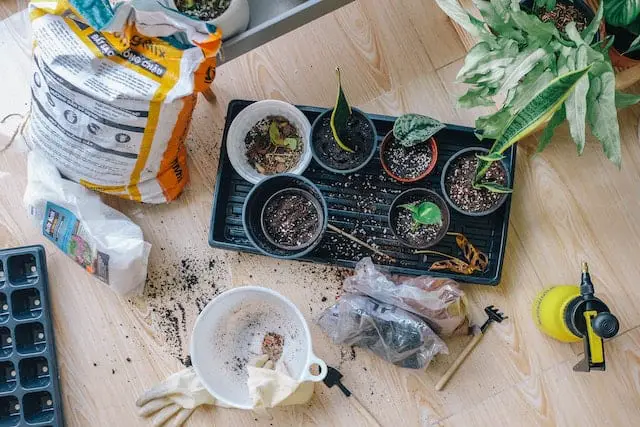
If your aloe plant is dying, propagating it can be a great way to save it. Propagation is the process of creating new plants from existing ones. Aloe plants can be propagated using cuttings or leaf cuttings.
1. Taking Cuttings
To take a cutting from your aloe plant, you will need a sharp, clean knife or pair of scissors. Cut a stem from the base of the plant, making sure it is at least 4-6 inches long. Allow the cutting to dry for a few days. Once it has formed a callus, you can plant it in a well-draining soil mix.
2. Planting New Aloe Plants
To plant a new aloe plant, fill a pot with a well-draining soil mix. Make a small hole in the soil and place the cutting in it. Cover the cutting with soil and water it lightly. Place the pot in a bright, indirect light and water it sparingly until the plant has established itself.
Alternatively, you can propagate aloe plants using leaf cuttings. To do this, remove a healthy leaf from the base of the plant and allow it to dry for a few days. Once it has formed a callus, plant the leaf in a well-draining soil mix. Water it sparingly until it has established itself.
Propagation can be a great way to save a dying aloe plant, and it can also be a fun way to grow new plants. With a little patience and care, you can have a whole collection of healthy aloe plants in no time.
Frequently Asked Questions
How do you save a dying aloe vera plant?
To save a dying aloe vera plant, it’s important to first identify the cause of the problem. Overwatering is a common issue that can lead to root rot and other diseases.
If the plant is overwatered, it’s important to remove it from the soil and allow the roots to dry out before replanting it in fresh soil. Underwatering can also cause an aloe vera plant to die, so make sure to water it regularly and adjust the watering routine as necessary.
What does an overwatered aloe plant look like?
An overwatered aloe plant may have yellow, brown, or swollen leaves. The leaves may also be soft and mushy to the touch. If the plant is overwatered, it’s important to remove it from the soil and allow the roots to dry out before replanting it in fresh soil.
How do you fix a damaged aloe vera plant?
To fix a damaged aloe vera plant, it’s important to first identify the cause of the problem. If the plant is overwatered, it’s important to remove it from the soil and allow the roots to dry out before replanting it in fresh soil. If the plant is underwatered, make sure to water it regularly and adjust the watering routine as necessary. It’s also important to make sure the plant is getting enough sunlight and is not exposed to temperatures below 50°F.
Do aloe plants come back?
In many cases, aloe plants can come back from being damaged or dying. However, it’s important to identify the cause of the problem and take steps to address it.
If the plant is overwatered, remove it from the soil and allow the roots to dry out before replanting it in fresh soil. If the plant is underwatered, make sure to water it regularly and adjust the watering routine as necessary.
What does an unhealthy aloe plant look like?
An unhealthy aloe plant may have yellow, brown, or swollen leaves. The leaves may also be soft and mushy to the touch. In some cases, the leaves may be puckering, dropping off, or becoming almost transparent. If you notice any of these symptoms, it’s important to take steps to address the problem.
Can I revive my dying aloe plant with warm water?
While warm water may help to revive a dying aloe plant, it’s important to first identify the cause of the problem. Overwatering and underwatering can both cause an aloe plant to die, so make sure to adjust the watering routine as necessary. It’s also important to make sure the plant is getting enough sunlight and is not exposed to temperatures below 50°F.

Hey, I’m Lisa and I’ve been an avid gardener for over 30 years. I love writing, talking and living in the garden! Feel free to connect with me on my socials below

